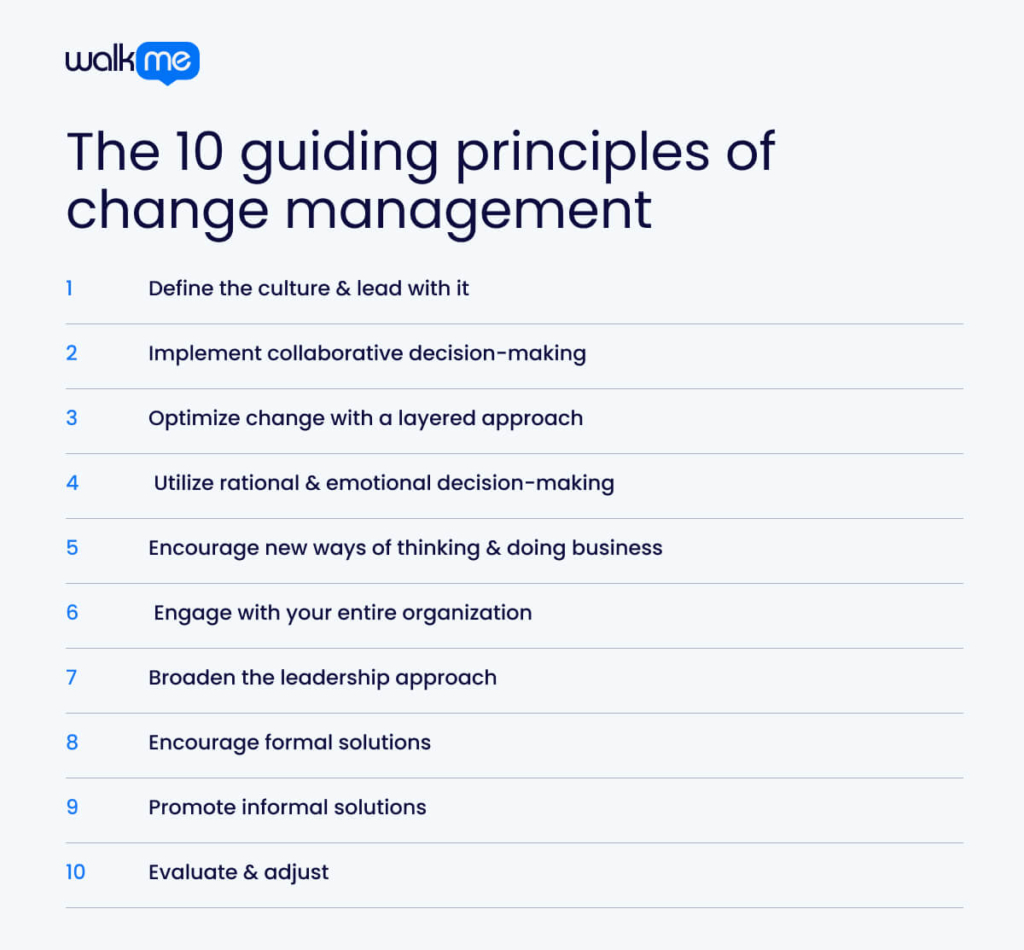Change is more prevalent than ever, with rapid technological advancements challenging organizations and their staff.
Employees struggle to keep up with new apps and evolving processes, highlighting the need for effective change management principles.
These principles provide a framework for guiding individuals and organizations through transitions, recognizing both the intellectual and emotional aspects of change.
Applying these principles allows management to effectively support staff through individual and organizational changes, promoting adaptability and resilience.
This article will explore the ten guiding principles of change management in depth to provide leaders and organizations with a framework for navigating transformational initiatives.

Let’s take a closer look at each principle in more detail:
1. Define the culture & lead with it
Leaders must understand the established culture and how to lead as part of the transformation strategy. Frameworks like the McKinsey 7S and Cultural Iceberg Model can help define company culture. Leaders unfamiliar with this process can hire change management consultants for expertise and objectivity in assessing organizational culture.
Culture is crucial for successful transformation. Understanding it helps reduce employee resistance by anticipating challenges and preparing support strategies. Once defined, leaders can drive change by leveraging cultural strengths and addressing weaknesses.
Leaders should be aware of various cultural models to choose the most appropriate for their organization. This knowledge allows them to effectively use culture as a tool in the change management process, ensuring a more successful and sustainable transformation.
2. Implement collaborative decision-making
Collaborative decision-making is essential for major change initiatives. Despite leaders claiming employee involvement, Gartner reports only 42% of employees feel heard and valued. Leaders often fear being overwhelmed by opinions and making decisions before seeking employee feedback as a formality.

One company created the Open Decision Framework to improve organizational change management. This tool, given to new hires, outlines how to include stakeholders in decision-making. The goal is to transform culture so employees contribute to change strategies without hindering productivity.
Instead of basing input on rank or tenure, leaders consider factors like expertise, impact, and customer service. This approach ensures transparency and understanding of decisions, even if not always liked.
While this may slow decision-making, it ultimately leads to greater savings and more effective change implementation.
3. Optimize change with a layered approach
Organizations must optimize change initiatives using a layered approach. Mid-level and frontline employees can significantly impact change efforts, and involving them early in decision-making smooths implementation.
Customer-facing staff often understand potential problems and consumer reactions to changes. Their investment can help complex initiatives succeed, while change resistance can hinder progress. To implement this approach, identify key stakeholders, including customer-facing teams.
Gather feedback from these teams and demonstrate that their input has been considered and acted upon. Effective communication by change leaders is crucial throughout this process. When done well, team members become change agents, motivated to communicate change needs and incentives to others.
This approach creates a network of engaged employees who understand and support the change initiative.
4. Utilize rational & emotional decision-making
Leaders often attempt to drive change by focusing solely on strategic business objectives, such as entering new markets or achieving growth targets. While these goals are practical, they rarely inspire genuine emotional commitment from employees.
Effective change management occurs when staff feel emotionally connected and engaged with change ideas, seeing themselves as part of a larger picture that benefits them.
Hewlett-Packard’s CEO Meg Whitman exemplifies this approach in their transformation efforts. They aim to connect HP and its employees personally by leveraging the company’s cultural heritage. Symbolic gestures, such as removing executive parking lot fences and moving top executives into cubicles, reinforce the “HP Way” ethic.
This approach emphasizes the quality of work over hierarchical position, fostering a sense of equality and shared purpose among all employees.
5. Encourage new ways of thinking & doing business
Change leaders often assume that formal elements like incentives and directives will automatically alter staff behaviors. However, change management is more complex, requiring new ways of thinking and operating for long-term implementation.
The key to success lies in people’s everyday behaviors. To achieve this, define a few essential behaviors and make them prominent in all activities.
Top executives must model these new behaviors to gain employee buy-in. Staff need to see leadership embodying the transformation to believe it’s genuine. For example, a global manufacturer facing bankruptcy addressed cultural issues by focusing on three key behaviors: quick decision-making, open discussions with frontline leadership, and encouraging direct customer engagement at all levels.
Due to their specific and limited nature, these targeted behavioral changes were easy to implement. Instead of slowly changing habits, leaders acted “as if” these behaviors were already established.
This approach helped the company avoid bankruptcy by increasing productivity and revenue. Successful change management thus relies on clear, actionable behavioral shifts modeled from the top down.
6. Engage with your entire organization
Change managers often mistakenly believe a strong initial message is sufficient for change implementation.
In reality, employees need constant communication throughout the rollout and beyond. Different types of communication reinforce each other, as exemplified by HP’s symbolic fence removal action.
A publishing company’s digital restructuring initiative demonstrates effective communication strategies. They used town hall meetings to announce changes and address concerns, followed by function-specific meetings to explain impacts on different departments. This approach kept employees informed and engaged.
Continuous communication maintained morale and encouraged stakeholder investment. The company implemented “PIE chats” covering performance, innovation, and execution topics. They also organized an internal trade fair showcasing digital progress across teams.
This multi-faceted communication strategy ensured broad involvement, keeping employees informed and invested in the company’s success throughout the change process. It highlights the importance of ongoing, diverse communication methods in successful change management.
7. Broaden the leadership approach
The most effective leaders recognize that change leadership can come from any level.
Gartner reports that only 39% of employees can respond to changing needs. However, when employees become change agents, they feel more in control and innovative, implementing change principles.
Leaders must influence organizational culture to boost employee trust and understanding, reducing change management demands as staff become self-motivated to implement changes.
“Special forces” are unofficial yet vital leaders, such as respected supervisors or innovative managers. Successful companies identify these individuals early and involve them as participants and mentors.
Informal leaders fall into three categories: pride builders, trusted nodes, and change ambassadors. Identifying these leaders, often through network analysis, allows for effective leadership from all organizational levels.
Leaders should communicate change plans with clear goals and maintain a transparent, accessible plan for staff. This approach leverages the combined strengths of all employees to support successful change implementation.
8. Encourage formal solutions
Transformation requires more than just changing staff behavior. Companies must redesign their structure, operations, training, rewards, and development programs for long-term stability.
For example, a company perceived as outdated by customers decided to formalize mentoring and development. They created a development committee and recruited experienced staff to mentor new hires. Initially, enthusiastic volunteers designed a comprehensive program.
However, the initiative lost momentum as participants became disengaged. Leadership identified the problem: lack of formal support and rewards for participation. Bonuses only considered work output, not training efforts, leading senior managers to undervalue the development committee’s work.
Recognizing this issue, company leaders adjusted policies to factor in trainers’ contributions to compensation. This case illustrates that sustainable change requires aligning organizational structures and incentives with new behaviors and goals. Such alignment is necessary for even well-intentioned change initiatives to succeed.
9. Promote informal solutions
Even with all tangible elements for change in place, people may revert to old habits, hindering progress. This is why combining formal and informal solutions is crucial.
A technology company aiming to shift focus from cost-cutting to customer satisfaction discovered through surveys that many customers were unhappy with product flaws. Therefore, it implemented new procedures and metrics for product development, quality control, and cross-team collaboration.
The most impactful change was informal and cultural. They changed the frontline motto from “ship by any means” to “if it’s not right, don’t ship it.” Pride builders were enlisted to demonstrate the importance of preventing flawed products from reaching customers, even if it meant additional inspection or temporary production halts.
These actions shifted the company’s focus from mere compliance to an ethic of ownership. Employees at all levels were made responsible for quality, with improvements celebrated. This combination of formal procedures and cultural change effectively transformed the company’s product quality and customer satisfaction approach.
10. Evaluate & adjust
Evaluation and adjustment are crucial for successful change efforts. Implementing change requires regular assessment and adjustment to maintain positive behavioral shifts and reduce office politics.
Many organizations prematurely claim victory without proper measurement. Leaders must evaluate what works and what doesn’t to guide future steps. Without this feedback loop, inconsistencies arise, depriving the organization of vital information for supporting long-term improvements.
A consumer goods company pledged to lower costs globally. They implemented an ambitious plan and initially relied on metrics. To ensure ongoing commitment, they launched pulse surveys and focus groups to discuss change needs and new behavioral expectations.
The first survey showed only 60% understood the message. The company enlisted informal leaders to help communicate the initiative. They continued surveys and focus groups until most staff felt prepared, increasing employee engagement.
These principles serve as a guide for leaders committed to long-term, positive change. While the transformation process is complex, the demand for such solutions continues to grow.
Principles of change management: Essential to modern success
Change is all around us—whether we like it or not, the business world is a constantly evolving, living being. The key to success lies in managing that change.
By understanding and practicing the principles of change management, we can ensure that changes are meaningful for employees who understand them and become passionate about change.
With the speed of digital innovation today, businesses cannot afford to delay implementing these principles to promote digital resilience.
Once you have begun implementing the principles, it is easy to see the positive impact as business outcomes and processes improve and staff becomes more motivated and productive in the long term.

